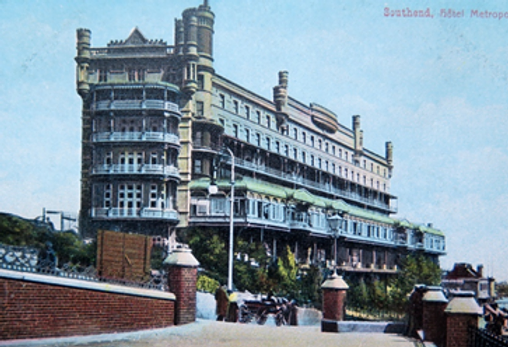How does the past of a town shape its present and future? In this blog about Southend – one of our case studies – historian Ken Crowe illustrates the radical expansion of tourism in the late 19th century and its impacts on local communities, economies and infrastructure’
Resorts tend to develop in response to the needs and classes of their visitors. There were four main factors that influenced the development of Southend as a resort in the second half of the 19th century.
· Proximity to a major urban centre – London
· Good and improving rail communications
· Improving living standards of the working classes in the late 19th century
· The response of the local authority to the increasing numbers of visitors
Southend was the nearest seaside resort to London; this was of increasing importance as the pursuit of leisure was taking over from health as the reason for visiting the seaside. With the extension of Southend’s pier in 1846 to 1 ¼ miles (into deep water), the numbers arriving at Southend by steam packet increased. The advertisements for the steamers assured nervous travellers that their fellow passengers were ‘highly respectable’, suggesting, in fact, that this almost certainly was not the case. At Margate, among the increasing numbers of visitors to that resort in the early 19th century were those of the ‘unfashionable classes.’ (N. Baker, et. al. Margate’s Seaside Heritage, (Swindon, 2007) 26-8).

Southend Pier about 1870 (Southend Museums Service)
In 1856 the London, Tilbury and Southend railway (LT &SR) was completed with the opening of Southend station. Almost immediately the Company advertised excursion trains to Southend. In 1859 special Easter Holiday excursion trains left Fenchurch Street at 10.07 am, returning from Southend at 6.30 pm; first class 3s. 6d., second class 2s. 6d. (The Era, 17 Apr. 1859).
In 1875 third-class carriages were introduced on the LT & SR line, and in 1888 the direct route (via Barking and Pitsea) was opened, cutting journey times from 90 minutes to under an hour. In 1889 the Great Eastern Railway opened their Victoria station at Southend, thus leading not only to increasing numbers of visitors (particularly from north-east London) but also intense competition for passengers between the two rail companies.
The Bank Holiday Act of 1871 coupled with improving living standards among the working classes towards the end of the 19th century and increased rail accommodation, saw huge increases in the numbers of day trippers or ‘excursionists’, together with those staying for two or more days over the August Bank holiday. [Ref: Walton, ‘Social Development of Blackpool’ Univ. Lancaster PhD, 1974, p. 3].

This, then, is the background to Southend’s development in the second half of the 19th century. The responses of both residents and the local authority to these factors helped to determine the nature of that development at this time. These responses may be grouped into three main headings: employment/economy relating to visitor needs; management of potential conflict between classes of visitors/holidaymakers; providing and improving or expanding facilities for visitors/holidaymakers. An additional area of investigation is the nature of the development of the residential aspect of the resort.
A major aspect of the economy of a resort was the provision of accommodation for the staying visitor, whether for a single night or for longer. Not only did this include the middle-class holidaymakers but, with improving living standards and disposable income of the working classes, visiting Southend could include a stay for a day or more, especially over the Bank Holiday weekends. Providing accommodation in a lodging or boarding house was a major, if precarious, source of seasonal income for many households. Lodging and boarding houses were clustered on the seafront (mainly Marine Parade) and on roads leading off the seafront (Brewery Road/Southchurch Avenue, Pleasant Road), and near Southend station, in the Cliff Town estate. Another cluster of lodging houses appeared in the roads forming the Lucas Estate, developed in the 1880s (e.g. Albert Road, St. Leonards Road). In addition to the lodging and boarding houses were the hotels, the largest of which were being constructed in the last decade of the 19th century. These included the Queen’s Hotel, the Hotel Victoria, the Hotel Metropole and the Westcliff Hotel. These were intended to attract the ‘better class’ of visitors, and to improve the ‘moral tone’ of the place.

Hotel Metropole, c. 1904. (Author’s Clln.)
The local authority in Southend, as those of other seaside resorts of this time, had to deal with the potential conflicts between the growing numbers of ‘working-class’ visitors and their needs, and the more traditional middle and upper-class visitors, whose patronage they needed to retain. The resolution of these (potential) conflicts played a major role in the development and appearance of the resort. In Southend a combination of by-laws and licensing confined most of the al fresco entertainments and catering stalls to the east side of the pier (Marine Parade and eastwards towards the Gas Works). It was here, also, that the Marine Park (later to become the Kursaal amusement park) was located, and the Warwick revolving tower.
Southend Municipal Borough Council (1892-1914) spent heavily on seafront schemes, although not as heavily as Blackpool. Several very grandiose schemes were put forward for widening and extending the seafront roads in the 1890s in response to ever increasing visitor numbers. Although the large-scale schemes proposed by, among others, the Borough Engineer (Alfred Fidler) were rejected, the piecemeal approach adopted resulted in the end (by c. 1910) a magnificent seafront esplanade from Chalkwell in the west to Southchurch and, eventually, all the way to Shoeburyness in the east.

Promenading on Western Esplanade, c. 1905. (Southend Museums Service)
Railways were the principal means of transport for the vast majority of visitors to Southend. The railway companies also played an important, though perhaps less obvious role, in both the physical development of the resort and, even less directly, in the provision of, or support for, entertainment for the masses.
Following the opening of Southend station in 1856, the contractors (Peto, Brassey and Betts) built a new estate (Cliff Town) immediately adjacent to the line, as they did at Lowestoft. Peto then offered reduced season ticket fares to those taking up residence in the new estate – the first commuters. In the later 19th century speculators such as Frederick Ramuz and his Land Company, made agreements with the rail companies, offering free or cheap fares and transport by special trains from London for potential buyers of building plots (particularly in the new ‘Westcliff-on-Sea’) – advertised as ideal for City men and their families. And, of course, the rail companies were at the forefront in advertising the resorts, in the hope of increasing passenger numbers. (See Ward & Hardy, 2004, for Ramuz).
Finally, the heads of the rail companies were sometimes involved more directly in supporting particular aspects of resort infrastructure. Charles Bischoff, the chairman of the LT & SR company, was a director of the failed Southend Marine Palace (1879) venture to build a large entertainment centre on the Cliffs, and Claud Hamilton, director of the GER Company, opened the Kursaal in July 1901, arrangements being made with the rail companies for reduced fares including admission to the buildings. (Crowe, 2003, 9).
References
Baker, N., Brodie, A., Dermont, N., Jessop, L., Winter, G. Margate’s Seaside Heritage. (Swindon, 2007) (http://historicengland.org.uk)
Crowe, K. Kursaal Memories, (St. Albans, 2003)
Vaughan, A. Samuel Morton Peto, (Hersham, 2009)
Walton, J.K. ‘Social Development of Blackpool’ Univ. Lancaster PhD, 1974 (http://www.uk.bl.ehtos.446436).
Ward, C., Hardy, D. Arcadia for All. (Five Leaves, 2004).
TNA BT 31/2489/12788 (Southend Marine Palace Co.)
Having retired from Southend Museum in 2014, Ken has been engaged in various research projects, including the Dissolution of the Monasteries in Essex and, more recently, working with a research team on the history of Southend in the 19th century for VCH Essex Trust. He is on the committees of Friends of Historic Essex and Essex Society for Archaeology and History.
This blog is based on research into the history of Southend in the 19th century for the Victoria County History (Essex) Trust. A team of volunteer researchers has been working towards a publication for the Trust of this VCH ‘Short’ on Southend, to be published during next year.
Victoria County History of Essex – Facebook | VCH Essex Trust (@Essex_VCH) – Twitter.



